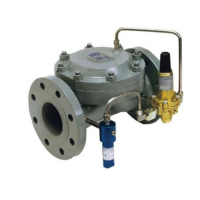Flowgrid Regulator | 15
Troubleshooting
First Steps
1. Verify the regulator specifications fit the application
conditions.
Min/max inlet pressure, control pressure range & min/max
operating differentials should be checked to make sure
the valve and pilot are designed to operate in the present
conditions.
2. Verify the regulator is piped correctly.
Even though the regulator may have operated in the past,
check that current piping connections match recom-
mendations on pages 7-10.
3. Verify the regulator is sized correctly.
Regulators operating below 10% or above 80% of their
maximum capacity given current application conditions
tend to have more problems. Consider reduced capacity
trim or a larger regulator in these cases.
Common Problems
Regulator does not shut off.
1. Refer to the failure mode chart to diagnose potential
causes.
2. Clean or replace valve and pilot components as
necessary.
Erratic Control.
1. Check for damage, debris in the restrictor and control
pilot. Replace, clean and lubricate components as
necessary. Consider pilot supply filtration (Type 30 Filter).
2. Check for the potential of hydrate formation or freezing
liquids in the pilot system. If liquids are present consider
gas conditioning before the pilot and/or valve, heating the
supply gas to the regulator, or heating the pilot supply gas
(pilot gas heater).
3. Check the sense line location and assure it is away
from turbulent locations. Moving the sense line to a new
location often solves control problems.
4. Check to make sure needle valves are not used on any
pilot system connections. Full opening type valves are
recommended.
5. Check for pilot vent port blockage.
Instability & Speed of response issues.
1. Change restrictor setting. Refer to page 11.
2. Check the sense line location and assure it is away
from turbulent locations. Moving the sense line to a new
location often solves control problems.
3. Check to make sure needle valves are not used on any
pilot system connections. Full opening type valves are
recommended.
4. Check for pilot vent port blockage.
The regulator will not regulate to set point or
“droops-off”.
1. Check for proper sizing. The regulator may be running out
of capacity during peak demand periods.
2. Adjust the restrictor to a higher gain (smaller) setting.
Refer to page 11.
The regulator fails open or fails closed.
1. Refer to the table below to diagnose failure modes.
Problem
Failure Mode
Fail
Open
Fail
Closed
Damage to the flexible element X X
Damage to the flexible element on the upstream
side (less likely)
X
Damage to the flexible element on the downstream
side (more likely)
X
Debris between the flexible element and the seat X
Blockage of pilot supply pressure X
Blockage* of the restrictor X
Blockage* of the pilot supply line X
Loss of the sense line (PRV pilot) X
Loss of the sense line (Relief Pilot) X
Blockage* of pilot discharge X
Pilot diaphragm rupture if (PRV pilot) X
Pilot diaphragm rupture if (BPV relief pilot) X
Blockage* of pilot orifice X
* Blockage can be caused by debris, hydrates, freezing or damage to the
component involved.

